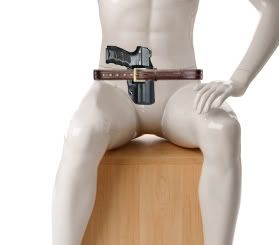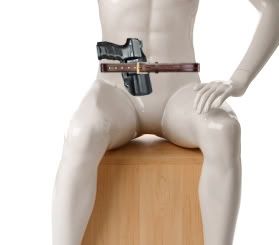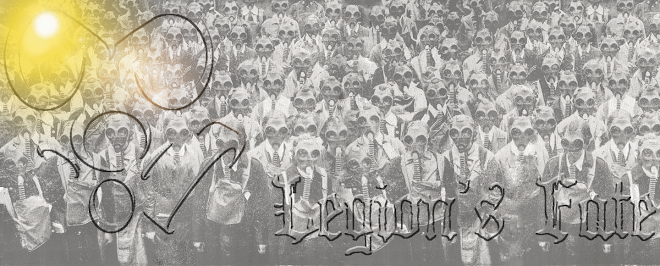Before we get into the pictures, the first thing to clear up is: Why? What does appendix carry (AIWB) have to offer that other modes of carry do not? The main answer is concealability. If you haven't noticed, there's an arms race amongst the firearm manufacturers to make the smallest and lightest blaster chambered in the largest caliber they can reasonable cram into it. The reason to go small is so you can conceal it, and thus not draw the ire and shame of your fellow Wal-Mart shoppers while browsing hemorrhoid cream. The only problem with that is that smaller guns are hard to shoot, are chambered in sub-calibers, hold limited ammunition, generate tons of muzzle flash, blast, and recoil, and with their small grips and frames can be more difficult to draw. A solution is to carry a larger gun, but they're harder to conceal. This is where AIWB comes in; I'm of average height, weight, and frame, and I can carry and conceal a Glock 17 -- a service sized pistol -- with absolute comfort all day long. Dropping down to Glock 19 or HK P30 size is no sweat, and now you have a gun that is reasonable in size, carries a standard payload of ammunition, has a full sized grip, and with its reasonable sight radius allows one to actually aim it instead of merely pointing. Second to that is draw speed approaching that of a USPSA Grand Master (a little bit of embellishment there, but lots of speed, none the less).
The main thing that the morons on gun forums chant is their squeamishness at pointing a holstered handgun at their twigs and berries, or femoral artery. First off, unless you're carrying a J-frame or short slide auto way off your centerline, you're not going to be aiming at your femoral artery, as I'm going to demonstrate. Second, get over the gun being pointed at your crotch; if it's in a serviceable holster, then the trigger is covered and there's nothing to be concerned about. If you have concerns that your gun will spontaneously discharge in your holster then carrying a firearm in any fashion is not for you. Have you ever tried pocket carry? Carried in a shoulder holster? If you have then your loaded albeit holstered handgun has been pointed at everyone: kids, grandma, the guy at register behind you at the liquor store; that's why you don't buy shitty holsters, so that when you snap your gun into that sucker it becomes just another inert object that you carry around with you.
Now that that's out of the way, here's some pics:
This is me with a Glock 17 carried appendix style:

The gun is close to my centerline, but not actually on it. I'd say it was at my 1 o'clock. This is what the gun looks like in relationship to my femoral artery:

Not pointing at it, huh? Amazing. Well now the next thing people whine about is how uncomfortable it "must" be when sitting. I say "must" because these folks have never tried to AIWB, or at the very best they pulled some canted IWB holster out of a box and gave it a try for ten minutes before passing judgment, and just assume that it's uncomfortable. I'm here to tell you that if you have a holster that lends itself to AIWB carry, it's as comfortable or more so than carrying on your hip. Here's why:

Yes, that's a creepy mannequin picture; get over it. Try googling "sitting mannequins" to get a sense at how disturbed this world really is, and then get back to me.
Anyhow, take notice of the crease of the hip meets the leg, and how the holster or muzzle avoids jamming into the thigh area. It really shouldn't touch it at all. Also notice that the gun and holster are sitting upright, so the back of the slide is not pushing into the abdomen. This picture depicts the gun at 12 o'clock, right on the centerline. If you want to move the gun further from the centerline and more towards your pocket, you need to either raise your pants or shorten the slide:


Some people still prefer to carry smaller guns like a J-frame revolver, and if you do then you can probably carry it directly over the leg, as the barrel is short enough to allow it. Doing that does make the gun point at the femoral artery, but if you have a serviceable holster then this is moot. The closer to your centerline the gun is, the longer slide/barrel length you can get away with. Go back to the first mannequin picture and see how much room you have for the muzzle. This is how people get away with carrying a full sized 1911. The only danger here is that with a long slide, you have to sit down on hard surfaces carfully, or you could smash a nut under the muzzle of the gun. So be smooth. Also, a gun with a longer slide/barrel will help to keep the grip tucked towards your body; where your body pushes out against the muzzle makes the gun see-saw against the belt, torquing the top of the gun in.
The other thing you can do is reverse-cant the holster:

This works fine as long as there's enough room to get your fingers wrapped around the grip; you don't want the grip to be sitting right on your belt unless you don't care if your draw speed is slowed down.
From what I gather, the belief about the gun being uncomfortable while sitting stems from the idea that the back of the slide, where the hammer is, will jam into your guts. If it is jamming into your guts then you have the wrong holster. . . period. It shouldn't happen. If you're sitting with a straight back, the gun should be straight up and down too. If you're reclined, the gun should be parallel with your spine. When you sit up, the gun should slide over your abdomen and rest vertical; wearing an undershirt helps this because it keeps the gun from grabbing at your skin and belly hairs. If you're going to experience discomfort, it's going to either be under your belt where it rides over the holster, or it's going to be in the crease of your crotch where the muzzle is. Concerning the former, loosening your belt a notch will usually fix the discomfort; and I highly recommend pants that have elastic sewn into the waist which will allow some "give" for when you get back into the car after eating two triple pounders with cheese. Regarding the latter, that's caused by your oversized guts pushing out on the back of the slide, using the belt as a fulcrum to tilt the muzzle into your body. A daily regime of exercise to lose your gut is one remedy, or you can go up one waist size for your pants. If you have a large gut, moving the gun away from your centerline will get it out of the way.
Hopefully this helps stiffle the yayhoos who don't know what they're talking about. I learn well from pictures, and showing the mechanics of what's involved can be helpful.

10 comments:
Interesting and very clear article. I've been considering AIWB carry (recently lost enough gut to make it feasible) but really had no idea of the considerations, other than the common fallacies you pointed out. Will bookmark this.
The proper argument about the safety of AIWB isn't about serviceable holsters but about accidentally pulling the trigger during the draw. That's why people like Michael Bane recommend double actions or manual safeties on guns used for AIWB.
Just a consideration.
David - I hear you on loosing the gut; I've been back and forth with that for awhile now. A smaller gut does help a whole lot.
Andy - I'd say re-holstering is the greatest fear. That reason alone is why I sought out a hammer fired gun; it's scary snapping a Glock back in there knowing that a corner of your T-shirt is all it takes to set that puppy off, and there's nothing you can do to prevent it. Add to that the adrenaline from being involved in a shooting and the likelyhood you could shoot yourself while reholstering goes way up. There's no shortage of people though who won't even give AIWB a try just for the fact that they can't get over the gun pointed at their balls. I can say that that fear goes away about ten minutes after trying it with a quality holster.
Reholstering AIWB depends on the holster. If it was that minimalist one you have that just has the trigger guard, that should be no problem. But in general I agree.
I keep advocating for the Zack holster for that very reason, but so far all the AIWB folks at P-F.com don't seem to think it's all that big of a deal. I need to make one for the P30. . .
Good Article About Appendix Carry Illustrated
yes i completely agree, appendix carry is the way to go. Irony is, i "look" like a gun guy, even though i try to play that aspect of my looks down.(i have been told i look like a cop, even though i am not). Funny thing is when people are looking me up and down looking for my firearm, they invariably hone in on my cell phone i carry in my front pocket, not the firearm i am carrying in the appendix position.
I have recently moved to an AIWB carry for my full-size 1911. I'm a big guy (6', 240pounds), and I carry at about 1:30 with about a 30 degree rear cant (I just rotate the whole holster on the belt). The barrel runs down the natural crease between my hip and my thigh. When I sit, the muzzle points slightly away from my body, so in the unlikely event that it discharged in the holster, I would hit my weak-side thigh. But, I carry on a regular basis, and the gun has an external safety, so I'm not too worried.
The draw is very fast, easy, and natural, and the grip of the 1911 disappears under a shirt worn outside the pants. There is very little printing, and it is *WAY* more comfortable, especially when driving. I'm looking forward to AIWB with the PPK/S I'm getting for Christmas -- it should work great in hot-weather clothes.
Quite interesting article, good to see such informative stuff about how to carry and positioned you concealed carry Gun.
Interesting thoughts.
Post a Comment